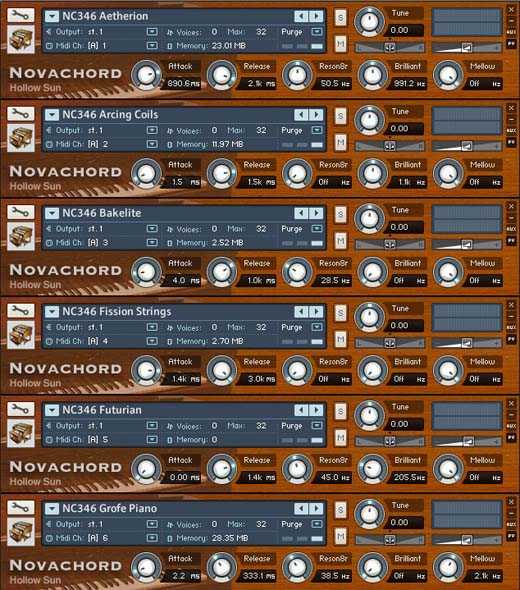
This has been possibly one of the most challenging projects I have been involved with to date. From the moment I had the first samples, I realised that that I had to roll my sleeves up and indulge in some real 'old skool' sample editing - no modern tools were going to help me out here if I was to preserve the Novachord's sound as authentically as possible. So it was back to basics ... which seemed apposite for an instrument from a distant yesteryear.
In the early days, we sampled what notes were working which was typically every minor third (+/-) but as the thing was renovated, we had more to play with so that we pretty much had one sample for every note. Of course, the Novachard isn't velocity sensitive so no velocity layers ... however, the sampled version has that using velocity to amplitude control.
We took long samples (as much as 15 - 20 seconds each in some cases) so that they had room to breathe (ermmmm... wheeze in some cases!) and each one was carefully topped and tailed and looped (where appropriate) by hand in order to preserve the quality of the original. This brought with it its own problems because each note was different and sometimes exhibited little electrical 'blips' (the result of 70 year old valves being a little unpredictable) which, when looped, sounded like a bad loop when the 'blip' cycled round so it was something of an ordeal to find the perfect loop point that was glitchless and seamless. Thankfully, 35 years of sample editing experience came into play here!

We preserved the original's envelope wherever possible but I did have to bring some of the samples into tune (some of the big, brass tuning chokes for the Novachord's master oscillators were turned to max) but this was just by a few cents and had no discernible effect on the sound.

We sampled with the Novachord's own vibrato. It would be easy enough to sample straight and add the vibrato in the sampler (and we did do that in some patches) but the Novachord's own 6-channel, electro-magnetic vibrato is such a distinctive characteristic of the sound, we just HAD to sample that if we were to capture the Novachord's true quality. Which was a bugger to loop I can tell you!!!
We took various sample sets with the Novachord's filters in different positions but the difference between them was pretty subtle on occasions but with a lot of experimentation in Kontakt, I discovered ways to go some way towards recreating some of the Novachord's distinctive sounds by patching in high, low and allpass filters in series ... much like the Novachord's own bank of 'resonators' but variable instead of switched and with a wider range. Using scripting, I put these on a custom 'skin' for immediate tweakability even if you don't want to hit Kontakt's 'monkey wrench' and delve deeper.

We also took some liberties with layering and modern synth facilities and effects to expand upon the Novachord's 'raw' sonic palette in some programs.
It has been a privilege to 'archive' this amazing instrument for posterity and I felt duty bound to preserve it as closely as possible without deviating too much. In a way, it's been a bit like being handed some film footage of a major event (like, for example, Bleriot's first flight across the English channel) and having to restore that for modern public consumption. Nowadays, you could use all sorts of CGI, etc., to do that but although I did a bit of that, I was also keen to 'keep it real' (as they say) and preserve the original sound with as little buggering about as possible, just some careful, hand crafted (and seamless) loops for sustained sounds.... to match Dan's ethos with this in his rebuilding of the actual Novachord - to have something as close as imaginable to how the thing would have sounded back in 1939, warts 'n' all!
I don't think Laurens Hammond is turning in his grave at the liberties we've taken - in fact, I'd like to think he'd be as excited by this project as we are.